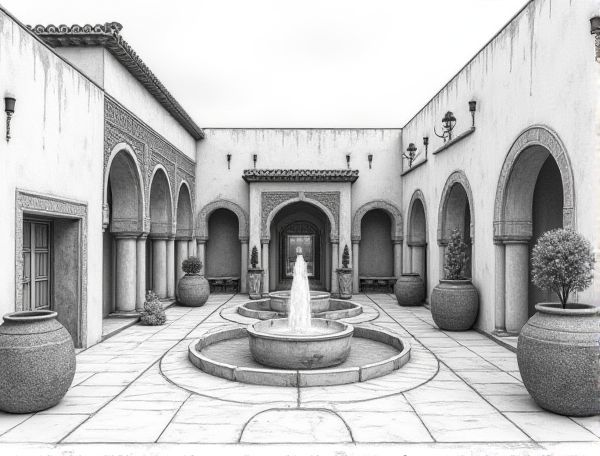
Photo illustration: Moroccan riad home design with central courtyard fountains
Moroccan riad home design features a stunning central courtyard with tranquil fountains that create a serene and inviting atmosphere, blending traditional craftsmanship with natural elements. Explore how incorporating these iconic courtyards can transform your living space by reading more in the article.
Introduction to Moroccan Riad Home Design
Moroccan riad home design features a central courtyard that provides natural light and ventilation, reflecting traditional Islamic architecture and promoting indoor-outdoor living. Intricate tilework, vibrant colors, and carved wood elements create a rich, sensory experience that emphasizes privacy and tranquility within urban environments.
Historical Significance of Central Courtyards
Central courtyards hold historical significance as architectural features dating back to ancient civilizations such as Mesopotamia and the Roman Empire, serving as focal points for ventilation and social interaction. These courtyards often symbolize cultural values, providing private yet communal spaces that reflect traditional lifestyles and climate adaptations. Their enduring design influences contemporary home architecture by integrating natural light and promoting harmonious indoor-outdoor living environments.
Key Architectural Elements of Riads
Key architectural elements of riads include an inward-focused courtyard with a central fountain, intricately carved wooden screens, and ornate tilework that enhances natural ventilation and light. Your home design can incorporate these features to create a serene, private oasis aligned with traditional Moroccan aesthetics.
The Role of Fountains in Moroccan Courtyards
Fountains in Moroccan courtyards serve as essential elements that enhance both aesthetic appeal and climate comfort. Their flowing water cools the surrounding air, creating a serene atmosphere while reflecting traditional Islamic design principles of balance and tranquility. Incorporating a fountain into Your home design evokes a rich cultural heritage and transforms outdoor spaces into peaceful retreats.
Traditional Materials and Craftsmanship
Traditional materials like natural wood, stone, and clay provide authentic textures and durability, while handcrafted techniques reflect cultural heritage and artisanal skill. Incorporating these elements in home design ensures timeless aesthetics, environmental sustainability, and a connection to local craftsmanship traditions.
Courtyard Landscape and Tilework Inspirations
Courtyard landscape and tilework inspirations transform your outdoor space into a harmonious blend of nature and artistry, highlighting elegant stone pathways, vibrant mosaics, and drought-resistant plants. Incorporating patterned tiles with earthy tones enhances visual texture while promoting durability and weather resistance, ideal for modern courtyards. Thoughtful integration of water features and native flora complements the tilework, creating a serene environment that balances aesthetics and functionality.
Incorporating Light and Shade in Riad Spaces
Incorporating light and shade in Riad spaces enhances the traditional architectural aesthetic by creating dynamic contrasts that emphasize intricate tilework and lush courtyards. Use of natural light through central skylights and strategically placed windows maximizes illumination while preserving privacy and coolness, essential for the Mediterranean climate. Combining shaded alcoves and pergolas with reflective surfaces intensifies spatial depth and fosters a serene ambiance, blending functionality with cultural heritage.
Tips for Modern Riad-Style Home Interiors
Incorporate natural materials like wood, stone, and ceramic tiles to authentically capture the essence of a modern Riad-style home interior, emphasizing open courtyards that invite natural light and air. Your design should balance intricate Moroccan patterns with minimalist furniture to create a serene yet visually stunning living space.
Creating a Tranquil Oasis with Water Features
Incorporating water features such as fountains, ponds, or waterfalls enhances home design by promoting relaxation and reducing stress through the soothing sound of flowing water. Strategically placing these elements in gardens or patios transforms outdoor spaces into serene retreats, increasing property value and aesthetic appeal.
Sustainable Practices in Contemporary Riad Design
Sustainable practices in contemporary riad design emphasize the integration of energy-efficient systems, water-saving fixtures, and locally sourced materials to minimize environmental impact while preserving traditional Moroccan architectural elements. Incorporating natural ventilation, solar panels, and eco-friendly insulation enhances comfort and reduces the carbon footprint, aligning modern luxury with ecological responsibility.
 homedesy.com
homedesy.com